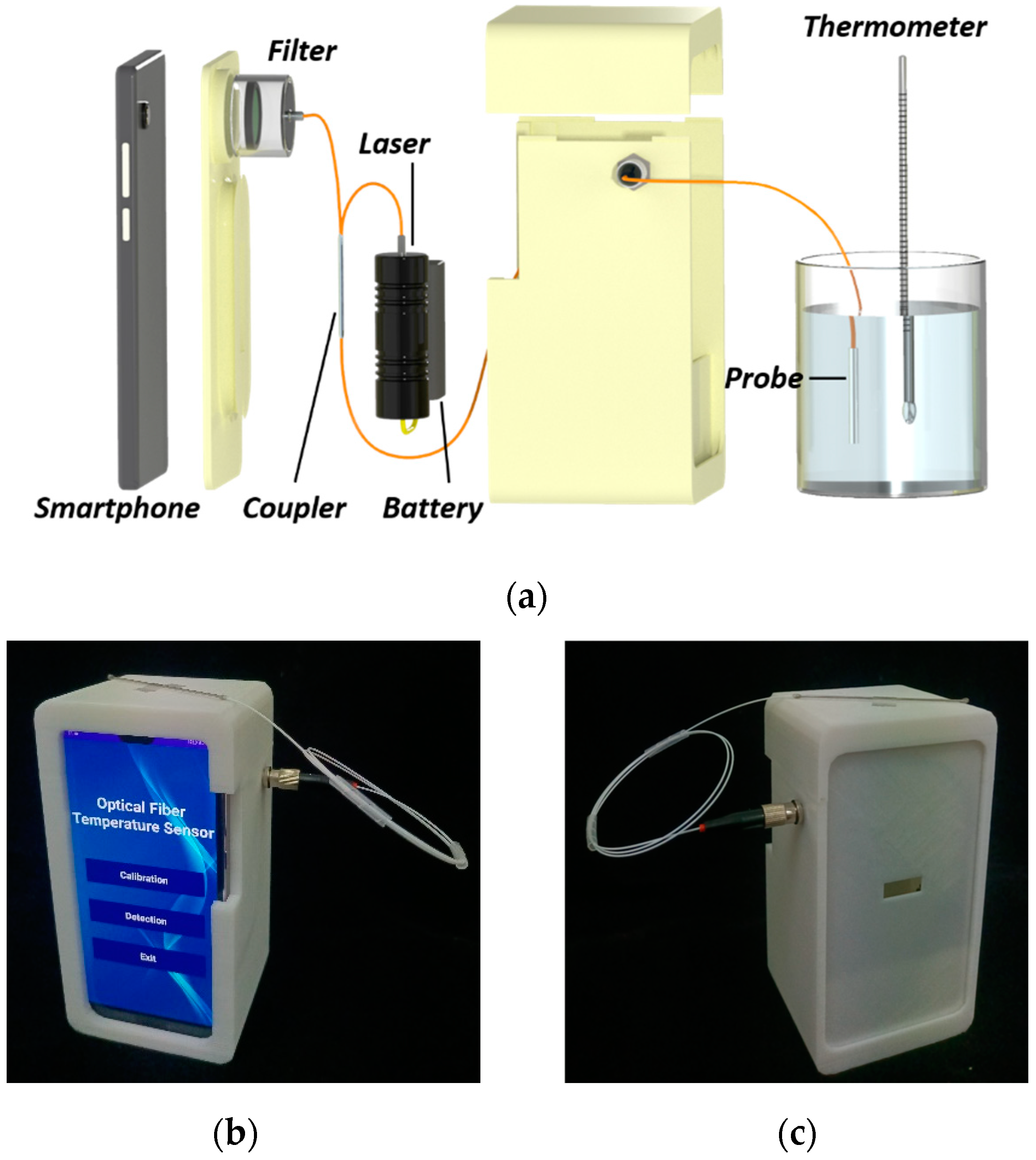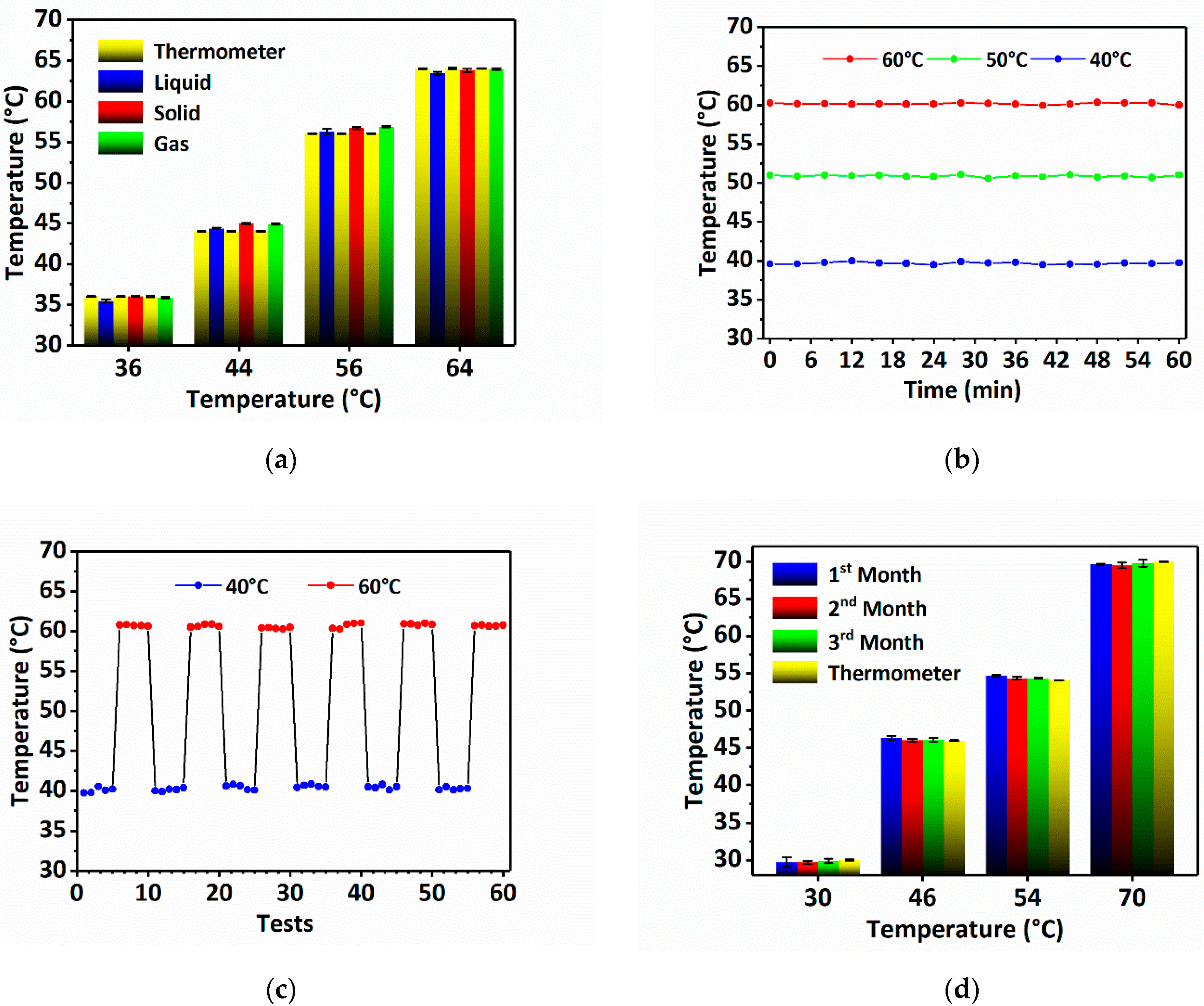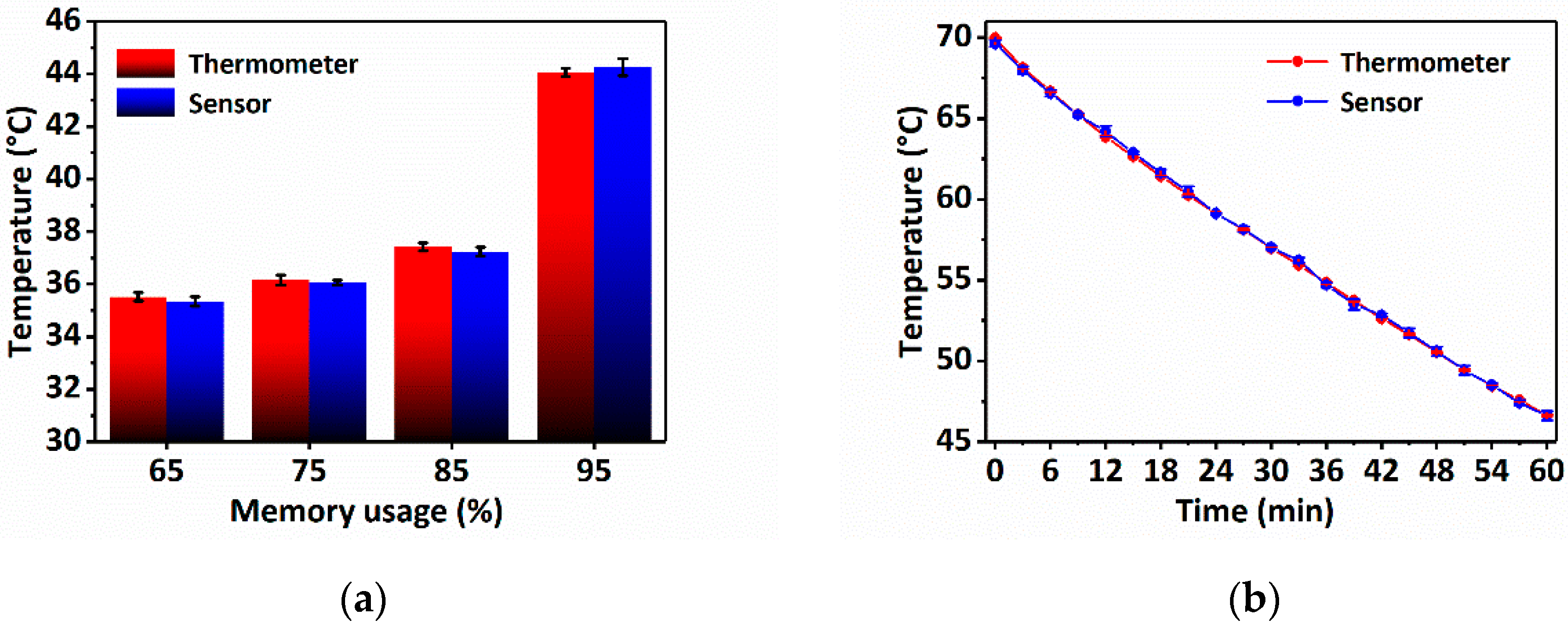Smartphone-Based Optical Fiber Fluorescence Temperature Sensor
Abstract
1. Introduction
2. Sensing Probe Preparation and Sensor Construction
2.1. Sensing Probe Preparation
2.2. Sensor Construction
2.3. Software Design
3. Results and Discussion
3.1. Sensing Probe Optimization
3.2. Sensor Calibration
3.3. Sensor Performance Verification
3.4. Sensor Practical Applications
3.5. Discussion
4. Conclusions
Author Contributions
Funding
Institutional Review Board Statement
Informed Consent Statement
Data Availability Statement
Conflicts of Interest
References
- Othayq, M.M.; Giganti, N.; Shavezipur, M. Development of capacitive temperature sensors with high sensitivity using a multiuser polycrystalline silicon process. Microelectron. Eng. 2020, 226, 111287. [Google Scholar] [CrossRef]
- Tian, B.; Liu, Y.; Zhang, Z.; Zhao, L.; Liu, Z.; Shi, P.; Lin, Q.; Mao, Q.; Lu, D.; Jiang, Z. WRe26–In2O3 probe-type thin film thermocouples applied to high temperature measurement. Rev. Sci. Instrum. 2020, 91, 074901. [Google Scholar] [CrossRef] [PubMed]
- Li, L.; Li, X.; Pu, T.; Cheng, S.; Li, H.; Ao, J. Vertical GaN-based temperature sensor by using TiN anode schottky barrier diode. IEEE Sens. J. 2021, 21, 1273–1278. [Google Scholar] [CrossRef]
- Niu, S.; Chang, X.; Zhu, Z.; Qin, Z.; Li, J.; Jiang, Y.; Wang, D.; Yang, C.; Gao, Y.; Sun, S. Low-temperature wearable strain sensor based on a silver nanowires/graphene composite with a near-zero temperature coefficient of resistance. ACS Appl. Mater. Interfaces 2021, 13, 55296–55307. [Google Scholar] [CrossRef] [PubMed]
- Haque, F.; Lim, S.; Lee, S.; Park, Y.; Mativenga, M. Highly sensitive and ambient air-processed hybrid perovskite TFT temperature sensor. IEEE Electron Device Lett. 2020, 41, 1086–1089. [Google Scholar] [CrossRef]
- Li, H.; Qian, X.; Zheng, W.; Lu, Y.; E, S.; Zhang, Y.-N. Theoretical and experimental characterization of a salinity and temperature sensor employing optical fiber surface plasmon resonance (SPR). Instrum. Sci. Technol. 2020, 48, 601–615. [Google Scholar] [CrossRef]
- Zhou, X.; Li, S.; Li, X.; Yan, X.; Zhang, X.; Wang, F.; Cheng, T. High-sensitivity SPR temperature sensor based on hollow-core fiber. IEEE Trans. Instrum. Meas. 2020, 69, 8494–8499. [Google Scholar] [CrossRef]
- Luo, W.; Meng, J.; Li, X.; Xie, Q.; Yi, D.; Wang, Y.; Hong, X. Temperature effects on surface plasmon resonance sensor based on side-polished D-shaped photonic crystal fiber. Measurement 2021, 181, 109504. [Google Scholar] [CrossRef]
- Zhang, S.; Geng, T.; Wang, S.; Niu, H.; Li, X.; Deng, S.; Wang, Z.; Sun, C.; Ma, Y.; Yang, W.; et al. High-sensitivity strain and temperature simultaneous measurement sensor based on multimode fiber chirped long-period grating. IEEE Sens. J. 2020, 20, 14843–14849. [Google Scholar] [CrossRef]
- Zhao, Y.; Liu, S.; Luo, J.; Chen, Y.; Fu, C.; Xiong, C.; Wang, Y.; Jing, S.; Bai, Z.; Liao, C. Torsion, refractive index, and temperature sensors based on an improved helical long period fiber grating. J. Lightwave Technol. 2020, 38, 2504–2510. [Google Scholar] [CrossRef]
- Annunziato, A.; Anelli, F.; Gates, J.; Holmes, C.; Prudenzano, F. Design of polarization-maintaining FBGs using polyimide films to improve strain-temperature sensing in CFRP laminates. IEEE Photon.-J. 2021, 13, 7100315. [Google Scholar] [CrossRef]
- Abadla, M.M.; Elsayed, H.A.E.; Mehaney, A. Sensitivity enhancement of annular one dimensional photonic crystals temperature sensors with nematic liquid crystals. Phys. Scr. 2020, 95, 085508. [Google Scholar] [CrossRef]
- Dhara, P.; Singh, V.K. Investigation of rectangular solid-core photonic crystal fiber as temperature sensor. Microsyst. Technol. 2020, 27, 127–132. [Google Scholar] [CrossRef]
- Sun, Y.; Yan, X.; Wang, F.; Zhang, X.; Li, S.; Suzuki, T.; Ohishi, Y.; Cheng, T. Theoretical investigation of an alcohol-filled tellurite photonic crystal fiber temperature sensor based on four-wave mixing. Sensors 2020, 20, 1007. [Google Scholar] [CrossRef]
- Lecieux, Y.; Lupi, C.; Leduc, D.; Macé, Q.; Jeanneau, V.; Guigue, P. Instrumentation of stratospheric balloon straps with optical fibre for temperature and strain monitoring. Sensors 2020, 20, 1433. [Google Scholar] [CrossRef]
- Sheng, L.; Li, L.; Hu, L.; Yuan, M.; Lang, J.; Wang, J.; Li, P.; Bi, Z.; Yan, J.; Liu, Z. Distributed fiberoptic sensor for simultaneous temperature and strain monitoring based on brillouin scattering effect in polyimide-coated fibers. Int. J. Opt. 2020, 2020, 8810986. [Google Scholar] [CrossRef]
- Hu, L.; Sheng, L.; Yan, J.; Li, L.; Yuan, M.; Sun, F.; Nian, F.; Li, L.; Liu, J.; Zhou, S.; et al. Simultaneous measurement of distributed temperature and strain through brillouin frequency shift using a common communication optical fiber. Int. J. Opt. 2021, 2021, 6610674. [Google Scholar] [CrossRef]
- Lyu, D.; Peng, J.; Huang, Q.; Zheng, W.; Xiong, L.; Yang, M. Radiation-resistant optical fiber fabry-perot interferometer used for high-temperature sensing. IEEE Sens. J. 2021, 21, 57–61. [Google Scholar] [CrossRef]
- Pan, R.; Yang, W.; Li, L.; Yang, Y.; Zhang, L.; Yu, X.; Fan, J.; Yu, S.; Xiong, Y. A high-sensitive fiber-optic fabry-perot sensor with parallel polymer-air cavities based on vernier effect for simultaneous measurement of pressure and temperature. IEEE Sens. J. 2021, 21, 21577–21585. [Google Scholar] [CrossRef]
- Yu, X.; Wang, S.; Jiang, J.; Liu, K.; Dong, J.; Zhang, P.; Wu, W.; Liu, T. Hybrid sapphire dual-fabry—Perot-cavities sensor for high temperature and refractive index measurement. J. Lightwave Technol. 2020, 39, 3911–3918. [Google Scholar] [CrossRef]
- Guo, J.; Zhou, B.; Yang, C.; Dai, Q.; Kong, L. Stretchable and temperature-sensitive polymer optical fibers for wearable health monitoring. Adv. Funct. Mater. 2019, 29, 1902898. [Google Scholar] [CrossRef]
- Yang, K.; Xu, R.; Meng, Q.; Chen, L.; Zhao, S.; Shen, Y.; Xu, S. Er3+/Yb3+ co-doped TeO2-ZnO-ZnF2-La2O3 glass with a high fluorescence intensity ratio for an all-fiber temperature sensor. J. Lumin. 2020, 222, 117145. [Google Scholar] [CrossRef]
- Ren, X.; Gao, J.; Shi, H.; Zhao, S.; Huang, L.; Xu, S. A flexible and portable all-fiber temperature sensor based on the upconversion luminescence of octahedral NaBi(WO4)2:Er3+/Yb3+ phosphors. Dalton Trans. 2021, 50, 917–925. [Google Scholar] [CrossRef] [PubMed]
- Tao, S.; Jayaprakash, A. A fiber optic temperature sensor with an epoxy-glue membrane as a temperature indicator. Sens. Actuators B Chem. 2006, 119, 615–620. [Google Scholar] [CrossRef]
- Liu, T.; Huang, J.; Ding, H.; Zhan, C.; Wang, S. Molecular structure perspective on temperature-sensitive properties of rhodamine aqueous solutions. Spectrochim. Acta Part A Mol. Biomol. Spectrosc. 2022, 275, 121166. [Google Scholar] [CrossRef] [PubMed]
- Zehentbauer, F.M.; Moretto, C.; Stephen, R.; Thevar, T.; Gilchrist, J.R.; Pokrajac, D.; Richard, K.L.; Kiefer, J. Fluorescence spectroscopy of Rhodamine 6G: Concentration and solvent effects. Spectrochim. Acta Part A Mol. Biomol. Spectrosc. 2014, 121, 147–151. [Google Scholar] [CrossRef] [PubMed]
- Rahdar, A.; Almasi-Kashi, M. Photophysics of rhodamine B in the nanosized water droplets: A concentration dependence study. J. Mol. Liq. 2016, 220, 395–403. [Google Scholar] [CrossRef]
- Castrellon-Uribe, J.; Garcia-Torales, G. Remote temperature sensor based on the up-conversion fluorescence power ratio of an erbium-doped silica fiber pumped at 975 nm. Fiber Integr. Opt. 2010, 29, 272–283. [Google Scholar] [CrossRef]
- Bao, R.; An, N.; Ye, L.; Wang, L.-G. Wide-range temperature sensor based on enhanced up-conversion luminescence in Er3+/Yb3+ co-doped Y2O3 crystal fiber. Opt. Fiber Technol. 2019, 52, 101989. [Google Scholar] [CrossRef]
- Zhang, G.; Yu, B.; Cao, Z.; Lu, L.; Xu, F.; Zhuang, Z.; Wang, Y. A low loss quantum-dot-doped optical fiber temperature sensor based on flexible print technology. IEEE Photon.-J. 2020, 12, 7101008. [Google Scholar] [CrossRef]
- Zhao, F.; Kim, J.; Fei, Z.; Jongsung, K. The effect of temperature on photoluminescence enhancement of quantum dots in brain slices. J. Nanosci. Nanotechnol. 2017, 17, 2606–2609. [Google Scholar] [CrossRef] [PubMed]
- Zhao, Y.; Pang, C.; Wen, Z.; Liu, Y.; Qiao, X.; Yang, Z.; Raghavan, N.; Zhao, Y.; Yang, Q. A microfiber temperature sensor based on fluorescence lifetime. Opt. Commun. 2018, 426, 231–236. [Google Scholar] [CrossRef]
- Zhang, H.; Ye, J.; Wang, X.; Zhao, S.; Lei, R.; Huang, L.; Xu, S. Highly reliable all-fiber temperature sensor based on the fluorescence intensity ratio (FIR) technique in Er3+/Yb3+ co-doped NaYF4 phosphors. J. Mater. Chem. C 2019, 7, 15269–15275. [Google Scholar] [CrossRef]
- Zhao, Y.; Tong, R.-J.; Chen, M.-Q.; Xia, F. Fluorescence temperature sensor based on GQDs solution encapsulated in hollow core fiber. IEEE Photon.-Technol. Lett. 2017, 29, 1544–1547. [Google Scholar] [CrossRef]
- Zhang, M.; Li, A.; Yu, J.; Lu, X.; Wang, S.; Lewis, E.; Farrell, G.; Yuan, L.; Wang, P. In-fiber temperature sensor based on green up-conversion luminescence in an Er3+-Yb3+ co-doped tellurite glass microsphere. Opt. Lett. 2019, 44, 3214–3217. [Google Scholar] [CrossRef]
- Mai, Y.; Li, B.; Zhou, G.; Wu, M. Research on temperature sensor using rhodamine 6G film coated microstructure optical fiber. IEEE Sens. J. 2019, 20, 202–207. [Google Scholar] [CrossRef]








| Sensing Probe Preparation Method | Sensing Probe Preparation Complexity | Signal Processing Unit | Sensor Cost | Refs |
|---|---|---|---|---|
| Doping method | Normal | Spectrometer | High | [21,28,29,30] |
| Physical deposition and chemical modification method | Normal | Spectrometer | High | [31,32,33] |
| Special optical fiber filling method | Complex | Spectrometer /optical spectrum analyzer | High | [34,35,36] |
| Filling-and-connecting method | Easy | Smartphone | Low | This work |
Publisher’s Note: MDPI stays neutral with regard to jurisdictional claims in published maps and institutional affiliations. |
© 2022 by the authors. Licensee MDPI, Basel, Switzerland. This article is an open access article distributed under the terms and conditions of the Creative Commons Attribution (CC BY) license (https://creativecommons.org/licenses/by/4.0/).
Share and Cite
Huang, J.; Liu, T.; Zhang, Y.; Zhan, C.; Xie, X.; Yu, Q.; Yi, D. Smartphone-Based Optical Fiber Fluorescence Temperature Sensor. Sensors 2022, 22, 9605. https://doi.org/10.3390/s22249605
Huang J, Liu T, Zhang Y, Zhan C, Xie X, Yu Q, Yi D. Smartphone-Based Optical Fiber Fluorescence Temperature Sensor. Sensors. 2022; 22(24):9605. https://doi.org/10.3390/s22249605
Chicago/Turabian StyleHuang, Jianwei, Ting Liu, Yeyu Zhang, Chengsen Zhan, Xiaona Xie, Qing Yu, and Dingrong Yi. 2022. "Smartphone-Based Optical Fiber Fluorescence Temperature Sensor" Sensors 22, no. 24: 9605. https://doi.org/10.3390/s22249605
APA StyleHuang, J., Liu, T., Zhang, Y., Zhan, C., Xie, X., Yu, Q., & Yi, D. (2022). Smartphone-Based Optical Fiber Fluorescence Temperature Sensor. Sensors, 22(24), 9605. https://doi.org/10.3390/s22249605






